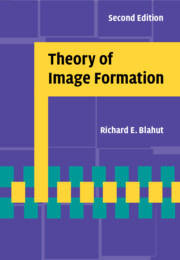Refine search
Actions for selected content:
526 results in Image processing and machine vision
12 - Radar Search Systems
-
- Book:
- Theory of Image Formation
- Published online:
- 17 April 2025
- Print publication:
- 24 April 2025, pp 480-520
-
- Chapter
- Export citation
Frontmatter
-
- Book:
- Theory of Image Formation
- Published online:
- 17 April 2025
- Print publication:
- 24 April 2025, pp i-iv
-
- Chapter
- Export citation
15 - Phase Noise and Phase Distortion
-
- Book:
- Theory of Image Formation
- Published online:
- 17 April 2025
- Print publication:
- 24 April 2025, pp 575-589
-
- Chapter
- Export citation
Acknowledgments
-
- Book:
- Theory of Image Formation
- Published online:
- 17 April 2025
- Print publication:
- 24 April 2025, pp xvi-xviii
-
- Chapter
- Export citation

Theory of Image Formation
-
- Published online:
- 17 April 2025
- Print publication:
- 24 April 2025
2 - Bird’s–Eye View
-
- Book:
- Virtual Reality
- Published online:
- 12 October 2023
- Print publication:
- 02 November 2023, pp 31-54
-
- Chapter
- Export citation
6 - Visual Perception
-
- Book:
- Virtual Reality
- Published online:
- 12 October 2023
- Print publication:
- 02 November 2023, pp 129-154
-
- Chapter
- Export citation
10 - Interaction
-
- Book:
- Virtual Reality
- Published online:
- 12 October 2023
- Print publication:
- 02 November 2023, pp 245-270
-
- Chapter
- Export citation
11 - Audio
-
- Book:
- Virtual Reality
- Published online:
- 12 October 2023
- Print publication:
- 02 November 2023, pp 271-292
-
- Chapter
- Export citation
9 - Tracking
-
- Book:
- Virtual Reality
- Published online:
- 12 October 2023
- Print publication:
- 02 November 2023, pp 211-244
-
- Chapter
- Export citation
References
-
- Book:
- Virtual Reality
- Published online:
- 12 October 2023
- Print publication:
- 02 November 2023, pp 340-356
-
- Chapter
- Export citation
3 - The Geometry of Virtual Worlds
-
- Book:
- Virtual Reality
- Published online:
- 12 October 2023
- Print publication:
- 02 November 2023, pp 55-81
-
- Chapter
- Export citation
1 - Introduction
-
- Book:
- Virtual Reality
- Published online:
- 12 October 2023
- Print publication:
- 02 November 2023, pp 1-30
-
- Chapter
- Export citation
7 - Visual Rendering
-
- Book:
- Virtual Reality
- Published online:
- 12 October 2023
- Print publication:
- 02 November 2023, pp 155-184
-
- Chapter
- Export citation
8 - Motion in Real and Virtual Worlds
-
- Book:
- Virtual Reality
- Published online:
- 12 October 2023
- Print publication:
- 02 November 2023, pp 185-210
-
- Chapter
- Export citation
12 - Evaluating VR Systems and Experiences
-
- Book:
- Virtual Reality
- Published online:
- 12 October 2023
- Print publication:
- 02 November 2023, pp 293-319
-
- Chapter
- Export citation
5 - The Physiology of Human Vision
-
- Book:
- Virtual Reality
- Published online:
- 12 October 2023
- Print publication:
- 02 November 2023, pp 107-128
-
- Chapter
- Export citation
Contents
-
- Book:
- Virtual Reality
- Published online:
- 12 October 2023
- Print publication:
- 02 November 2023, pp vii-x
-
- Chapter
- Export citation
4 - Light and Optics
-
- Book:
- Virtual Reality
- Published online:
- 12 October 2023
- Print publication:
- 02 November 2023, pp 82-106
-
- Chapter
- Export citation
Preface
-
- Book:
- Virtual Reality
- Published online:
- 12 October 2023
- Print publication:
- 02 November 2023, pp xi-xiii
-
- Chapter
- Export citation
